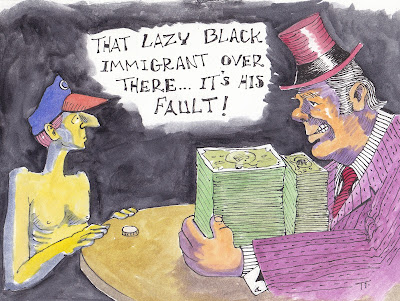Many of Chomsky’s recent books are more or less transcriptions of interviews by David Barsamian. They explore questions such as, Why does the radical right oppose social security, both today and at its birth?, and public education, the most recent strategy being charter schools? Chomsky’s take is that these social functions create solidarity, they contribute to community and so undermine the notion, favored by the right, that we’re on our own, isolated individuals looking out for number one! Solidarity, working together, threatens elite-rule. The Egyptian Spring and other uprisings worry the elite and when they’re worried they double down on the propaganda machine.
Aristotle, according to Chomsky, concluded, after studying governing options, that democracy was probably the best one. A problem though is that since the poor vastly outnumber the rich, under democracy the poor may decide to confiscate wealth. His solution to that problem was… LESS INEQUALITY. Alexander Hamilton, one of the founders of the United States offered, and he was not alone, a quite different solution to that problem… LESS DEMOCRACY. This polarity weaves throughout our history, the Hamilton faction all too often prevailing. The scapecoating and obsequious service to the 1% by republicans and democrats with expensive campaigns to run, scrutiny of that same class by the Bernie Sanders campaign are a current manifestation. The “middle ground” is occupied by the current frontrunner. The likely choice this Fall will, once again, be between the one who wants to break both of your legs and arms and the one who will only break the legs.
Among the elite there is a range of opinion that you can see reflected in the elite-owned mainstream media, presented as if that were the whole picture. The range is pretty much an argument on how big the middle class buffer between the rulers and the rabble need be. The faction that thinks it should be very small indeed has come to dominate since Reagan, forcing democrats into becoming “new democrats”, that is, republican-lite, what used to be moderate republicans, an extinct species.
An interesting diversion from the political, Barsamian inquires about language, the field where Chomsky made his professional reputation. He explains that language, unique to humans, has only been around about 100,000 years. This is too short a period to be explained by evolution. There must be some minor genetic variant accounting for it, just as in biology the difference between an elephant and a gnat reduces to that kind of slight genetic shift. Chomsky is 87 now and still going strong. In response to Barsamian’s question about how long he intends to maintain his activism he said he’d just keep going until he can’t anymore. The man flies all over the place giving talks, not hesitating to take the grueling flight to Turkey or South America. You’d think the guy often referred to as the greatest intellectual alive, the 8th most quoted author on the planet, might get a little mainstream media air-time but the the NO on this is predicted by Chomsky’s own analysis of the range of “respectable” opinion, being that range among the rulers, all else pretty much excluded.
But back to the political: part of how education is under attack, aside from the teach-to-test strategy that kills both love of learning and teaching, is in its approach. The pour water (information) into a bucket method is the current emphasis because it encourages obediance. The other method encourages learning to learn, creativity, questioning authority, obviously not supported by elite power. On top of this we have large increases in tuition that make higher education ever more elitist, limiting it to the wealthy or creating a sort of indentured debt that will channel behavior into repayment, leaving little time or energy for examining or questioning the 1% dominated system. There is no reason that the richest country on the planet cannot offer free education, K through college. It is done by Finland and most of Western Europe (although segments of elite forces there would very much like to emulate the United States – witness EU, German banks really, insistence on brutal austerity for Greece and Spain).
On the current presidential race Chomsky describes Sanders as a decent new-deal democrat, not a socialist as he claims. Clinton of course is republican-lite, a corporate business-as-usual candidate. Trump/Cruz, the whole remaining republican slate, represent blowback from years of vicious republican exploitation of basic fears and prejudices. After being manipulated into voting against their own interests in election after election citizens have begun to notice that something is wrong, things haven’t gotten better, quite the reverse. Trump is tapping into that malaise, offering up the usual targets/scapegoats but in a way that bombastically amplifies the previous more subtle manipulation. Ironically one of the biggest practitioners of what has created the malaise has convinced many that he is the solution. Kind of like Obama appointing Larry Summers and other designers of the financial disaster to administer the economy. Bernie Sanders also is tapping into that alienated demographic but in a way that actually addresses the causes of the insecurities and abandonment of large segments of the population. A serious transfer of wealth from workers to the already wealthy cannot be sustained without some kind of reaction. 1930s Germany demonstrated the kind of forces that can be unleashed when the masses of citizens are alienated and highly insecure economically.


